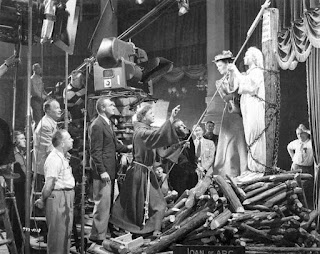SPOTLIGHT ON:
"HOUSE OF WAX" (1953)
Watch the trailer on our Facebook page
After master sculptor Professor Henry Jarrod's (Price) unscrupulous business partner, Matthew Burke (Roy Roberts), demands more sensational exhibits to increase profits are refused, Burke burns the museum down to collect the insurance money, leaving to die in the inferno as he tries to save his beloved wax figures. Months later, Burke is murdered by a cloaked, disfigured killer, who stages the crime as a suicide - also murdered was Burke's mistress, Cathy Gray (Carolyn Jones) and whose corpse mysteriously disappears from the morgue. Around this time, Jarrod reappears in public, having miraculously survived the fire, and proposes to open a new Wax Museum - this time, filled with all the horrors and gory scenes of death from the past in a "Chamber of Horrors". Aided by his deaf-mute sculptor Igor (Charles Bronson), Jarrod's opens his new museum with additional funding from businessman, Sidney Wallace (Paul Cavanagh). In attendance is a talented young sculptor, Scott Andrews (Paul Picerni) and Sue Allen (Phyllis Kirk) - Sue was also best friends with Cathy Gray before her death/disappearance. Roaming through the museum's collection of lifelike wax figures, Sue can't help but notice the strong resemblance the Joan of Arc figure has to her departed friend Cathy - and Jarrod cannot help but obsess about how much Sue resembles his long-lost Marie Antoinette figure!
Watch the trailer on our Facebook page
House of Wax, filmed under the working title The Wax Works, was Warner Bros.' answer to the surprise 3-D hit Bwana Devil, an independent production that premiered the previous November. Seeing something big in 3-D's future, Warner Bros. contracted Julian and Milton Gunzburg's Natural Vision 3-D system, the same one used for Bwana Devil, and filmed a remake of their 1933 thriller Mystery of the Wax Museum, with significant changes; the earlier film was set in the year it was released (1933) whereas House of Wax was moved back to circa 1902; the entire newspaper angle and the characters played by Glenda Farrell and Frank McHugh were eliminated; and while the masked figure was only seen sparingly in Mystery, making his identity a bit of a puzzle, he is shown early and often in this remake, leaving little doubt that it is indeed the sculptor.
Watch the trailer on our Facebook page
Like CinemaScope and other wider-and-larger-screen formats, stereoscopic 3-D was an alternative technology which employed separate 35 mm film prints for the left-eye and right-eye images, projected by two separate but interlocked projectors and shown by the polarized light method and viewed through gray-lensed polarized glasses (as were most of the 3D films of 1950's before they were replaced in the 1970's with red-and-blue-glasses anaglyph 3-D prints, negating the need for special projection equipment and a non-depolarizing screen).
Watch the trailer on our Facebook page
Ironically, director André de Toth was blind in one eye and unable to experience stereo vision or the 3-D effects. “It’s one of the great Hollywood stories,” Vincent Price recalled. “When they wanted a director for [a 3-D] film, they hired a man who couldn’t see 3-D at all! André de Toth was a very good director, but he really was the wrong director for 3-D. He’d go to the rushes and say, ‘Why is everybody so excited about this?’ It didn’t mean anything to him. But he made a good picture, a good thriller. He was largely responsible for the success of the picture. The 3-D tricks just happened—there weren’t a lot of them. Later on, they threw everything at everybody.
Watch the trailer on our Facebook page
Among the foregrounded uses of 3-D in the film were scenes featuring a wax museum fire, can-can girls, and a paddleball-wielding pitchman. In what may be the film's cleverest and most startling 3-D effect, the shadowy figure of one of the characters seems to spring up out of the theater audience and lurch into the screen. To accompany its stereoscopic imagery, House of Wax was originally available with a stereophonic three-track magnetic soundtrack, although many theaters were not equipped to make use of it and defaulted to the standard monophonic optical soundtrack. The film also included an intermission, which was necessary to change the film's reels, because each projector of the theater's two projectors was dedicated to one of the stereoscopic images, and could only hold enough film for a little over 40 minutes of screen time.
Released in 1953 to huge anticipation and was to become one of the biggest films of the year. Made with a budget of $1 million (or a little under $9 million adjusted for inflation), House of Wax was a phenomenal box office hit earning well over $200 million in today's currency ($23,750,000 in 1953), and was a smash with the critics of the day as well - and revitalized the film career of Vincent Price. After this high-profile role, he was always in high demand to play fiendish villains, mad scientists and other assorted deranged characters in genre films such as The Tingler, The Masque of the Red Death and The Abominable Dr. Phibes.
Although long seen only in "flat" 2-D form on television and in occasional revival theater screenings, by the mid-1960s it was usually listed among the classic horror films and even touted as the best US horror film of the 1950s. Warner Brothers' restoration of House of Wax for a 3D Blu-ray release cost $300,000. The original negatives were unusable because of water damage and the "Warnerphonic" stereo soundtrack no longer exists. Although still, to this day, House of Wax is greatly admired by critics and audiences as a classic horror film!
ROTTEN TOMATOES SCORE: 95%
Check out our Facebook page for exclusive trailers, news and much more!










No comments:
Post a Comment